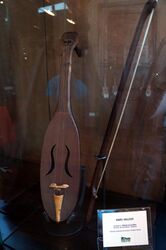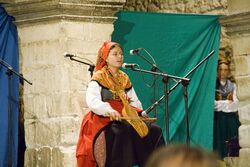Engineering:Rabel (instrument)
From HandWiki
Short description: Spanish bowed stringed instrument
 Galician Rabel | |
| String instrument | |
|---|---|
| Classification | String instrument |
| Hornbostel–Sachs classification | (Composite chordophone) |
| Related instruments | |
| Rebec, Rabeca | |
The rabel (or arrabel,[1] robel, rovel[2]) is a bowed stringed instrument from Spain, a rustic folk-fiddle descended from the medieval rebec,[citation needed] with both perhaps descended from the Arab rabab.[3] The instrument generally has two or three strings of gut or steel, or sometimes twisted horse-hair.[4][5] The instrument is first mentioned in the 12th century,[citation needed] and it is still used in parts of Latin America, as well as the Spanish provinces of Cantabria and Asturias.
See also
References
- ↑ Robert Williams Dale; James Guinness Rogers (1874). The Congregationalist. Hodder and Stoughton.. pp. 219–. https://books.google.com/books?id=s25JAAAAMAAJ&pg=PA219. Retrieved 15 June 2013.
- ↑ Stearns Collection of Musical Instruments; Frederick Stearns; Albert Augustus Stanley (1921). Catalogue of the Stearns collection of musical instruments. The University of Michigan. pp. 196–. https://books.google.com/books?id=LmwIAQAAMAAJ&pg=PA196. Retrieved 15 June 2013.
- ↑ Luisa Lacál (1899). Diccionario de la música, téchico, histórico, bio-bibliográfico. S.F. de Sales. pp. 428–. https://books.google.com/books?id=AQAQAAAAYAAJ&pg=PA428. Retrieved 15 June 2013.
- ↑ Tess Knighton; David Fallows (1992). Companion to Medieval and Renaissance Music. University of California Press. pp. 216–. ISBN 978-0-520-21081-3. https://books.google.com/books?id=_UmMn1EgB7IC&pg=PA216. Retrieved 15 June 2013.
- ↑ Bruno Nettl; Terry Ellis Miller; Sean Williams (1998). The Garland Encyclopedia of World Music: Southeast Asia. Garland Publishing. pp. 991–. ISBN 978-0-8240-6040-4. https://books.google.com/books?id=Xb2ibVAXO9sC&pg=PA991. Retrieved 15 June 2013.


